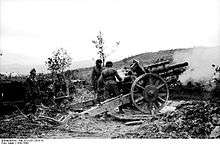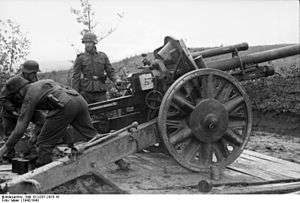10.5 cm leFH 18
| 10.5 cm leFH 18 | |
|---|---|
|
The 10.5 cm leFH 18 howitzer deployed on the Eastern Front | |
| Type | Howitzer |
| Place of origin | Nazi Germany |
| Service history | |
| In service | 1935–45 |
| Used by | Nazi Germany, China, Kingdom of Hungary, Spain, Finland, Bulgaria, Sweden |
| Wars | World War II |
| Production history | |
| Designed | 1929–30 |
| Manufacturer | Rheinmetall |
| Produced | 1935–45 |
| Number built | 6,986 from 1939-1945[1] |
| Specifications | |
| Weight | combat: 1,985 kg (4,377 lb) |
| Barrel length | 2.941 m (9 ft 8 in) L/28 (28 calibers) |
| Crew | 5 |
|
| |
| Shell | cased separate-loading (6 charges) |
| Shell weight |
14.81 kilograms (32.7 lb) (HE) 14.25 kilograms (31.4 lb) (AP) |
| Caliber | 105 mm (4.13 in) |
| Breech | horizontal sliding block |
| Recoil | hydropneumatic |
| Carriage | split trail |
| Elevation | -6° 30' to +40° 30' |
| Traverse | 56° |
| Rate of fire | 4-6 rpm |
| Muzzle velocity | 470 m/s (1,542 ft/s) |
| Maximum firing range | 10,675 m (11,675 yds) |
| Filling | TNT |
| Filling weight | 1.38 kg (3.0 lb) |
The 10.5 cm leFH 18 (German: leichte Feldhaubitze "light field howitzer") was a German light howitzer used in World War II.
History

The 10.5 cm leFH 18 was the standard divisional field howitzer used by the Wehrmacht during the Second World War. It was designed and developed by Rheinmetall in 1929–30 and entered service with the Wehrmacht in 1935. Generally it did not equip independent artillery battalions until after the Battle of Stalingrad in 1943. Before 1938 the leFH 18 was exported to Hungary and Spain. 53 were also exported to Finland, where they were known as 105 H 33. 166 leFH were exported to Bulgaria in 1943 and 1944 (until February 1, 1944)[2] Sweden purchased 142 leFH 18 howitzers from Germany between 1939 and 1942, designating it Haubits m/39. It was decommissioned from Swedish service in 1982. Also, 32 were to be exported to Estonia between December 1940 to June 1941, but due to the breakout of World War II, the orders were not fulfilled.[3] A video showing an alleged Wehrmacht leFH 18 in the possession of American-proxy fighters firing on Al-Fu'ah, Syria on Aug 30, 2015,[4] almost 80 years after the initial entry into Wehrmacht service.
Description
It had a heavy, simple breech mechanism with a hydro-pneumatic recoil system. The 10.5 cm leFH 18 had wood-spoked or pressed steel wheels. The former were only suitable for horse traction. Initially, it was not fitted with a muzzle brake. In 1941 a muzzle brake was fitted to allow longer range charges to be fired. This increased the range by about 1,650 metres and was known as the leFH 18M. In March 1942 a requirement was issued for a lighter howitzer. This led to a second modification, known as the leFH 18/40. This modification consisted of mounting the barrel of an leFH 18M on the carriage for a 7.5 cm PaK 40 antitank gun. The new carriage increased the rate of fire as well as making the howitzer lighter. Additionally, a more efficient muzzle brake was added, decreasing the recoil. Ballistically, the 10.5 cm leFH 18M and the leFH 18/40 are identical.
See also
References
- ↑ Das Deutsche Reich und der Zweite Weltkrieg, vol. 5, part 1.
- ↑ Петров, Людмил. Военната икономика на България 1919-1945, София 1999, с. 126. (Petrov, Lyudmil. Bulgaria's military economy 1919-1945, Sofia 1999, p. 126.)
- ↑ Salo, Urmas. Riigikaitse Nõukogu protokollid 1933-1939, Tartu 2013, p. 419.
- ↑ https://www.youtube.com/watch?v=2D_MmSDlmHk
Sources
- Engelmann, Joachim and Scheibert, Horst. Deutsche Artillerie 1934-1945: Eine Dokumentation in Text, Skizzen und Bildern: Ausrüstung, Gliederung, Ausbildung, Führung, Einsatz. Limburg/Lahn, Germany: C. A. Starke, 1974
- Gander, Terry and Chamberlain, Peter. Weapons of the Third Reich: An Encyclopedic Survey of All Small Arms, Artillery and Special Weapons of the German Land Forces 1939-1945. New York: Doubleday, 1979 ISBN 0-385-15090-3
- Hogg, Ian V. German Artillery of World War Two. 2nd corrected edition. Mechanicsville, PA: Stackpole Books, 1997 ISBN 1-85367-480-X
| Wikimedia Commons has media related to 10.5 cm leFH 18. |

